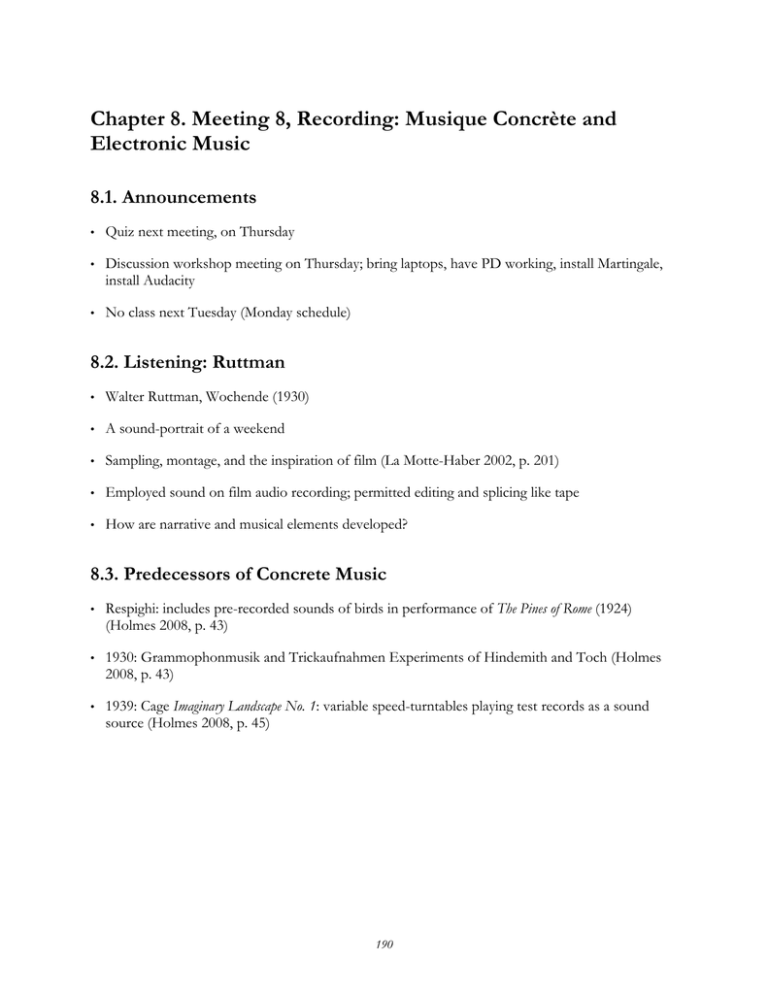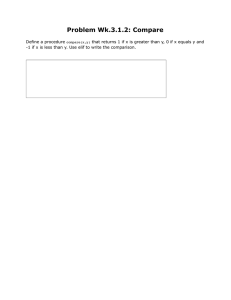
Chapter 8. Meeting 8, Recording: Musique Concrète and
Electronic Music
8.1. Announcements
•
Quiz next meeting, on Thursday
•
Discussion workshop meeting on Thursday; bring laptops, have PD working, install Martingale,
install Audacity
•
No class next Tuesday (Monday schedule)
8.2. Listening: Ruttman
•
Walter Ruttman, Wochende (1930)
•
A sound-portrait of a weekend
•
Sampling, montage, and the inspiration of film (La Motte-Haber 2002, p. 201)
•
Employed sound on film audio recording; permitted editing and splicing like tape
•
How are narrative and musical elements developed?
8.3. Predecessors of Concrete Music
•
Respighi: includes pre-recorded sounds of birds in performance of The Pines of Rome (1924)
(Holmes 2008, p. 43)
•
1930: Grammophonmusik and Trickaufnahmen Experiments of Hindemith and Toch (Holmes
2008, p. 43)
•
1939: Cage Imaginary Landscape No. 1: variable speed-turntables playing test records as a sound
source (Holmes 2008, p. 45)
190
8.4. Listening: Schaeffer
•
Pierre Schaeffer, Quatre études de bruits, 3. Etude aux chemins de fer, 1948
•
One of five studies of noise
8.5. Musique Concrète: Schaeffer
•
Trained as a radio engineer for Radiodiffusion-Television Française (RTF)
•
Early work in a radio opera, combining non-musical sounds in a radio montage: 1944: La Coquille
à planètes
•
Employed ideas of “sound object” from Abraham Moles (Holmes 2008, p. 45)
•
Goal of music made concretely, working directly with sounds, not music made abstractly, with
symbols (scores)
•
Any sound source could become musical
8.6. Musique Concrète: Original Techniques
•
In the late 1940s Schaeffer employed radio equipment at RTF
•
Recording directly to disc: no tape
•
Playback and mixing from four turntables (Holmes 2008, p. 49)
•
Microphones, audio filters, reverberation units
•
Sound effects libraries for radio
•
Lockgrooves as loops (Holmes 2008, p. 49)
•
1951: Schaeffer organizes studio with tape-based recorders, forms Groupe de Recherche de
Musique Concrète, by 1958 becomes Groupe de Recherches Musicales (GRM)
191
8.7. Early Tape Music: Tools and Techniques
•
Cutting, splicing, and mixing
•
Creative cutting to mask, fade, and alter amplitudes (Holmes 2008, p. 126)
•
Altering and reversing playback speed of tape [samplePlayer.pd]
•
With recording device
•
With a keyboard: the Phonogène à clavier (1952)
(c) Groupe de recherches musicales (GRM). All rights reserved. This content is excluded from our Creative Commons license.
For more information, see http://ocw.mit.edu/fairuse.
•
Filtering
•
Amplitude envelopes, amplitude modulation, ring modulation
•
Delays, loops, echos, feedback, and reverbs
•
With tape-based devices
•
With physical re-recording devices
8.8. The Click
•
When a signal is forced to jump to zero, a high frequency click occurs
192
•
Can happen when cutting between tape or digital audio
•
A technical error more often than an aesthetic choice [signalWaveforms.pd]
8.9. Listening: Schaeffer
•
Pierre Schaeffer, Etude aux objets, 2. Objets étendus , 1959
•
Extended, or wide, objects
8.10. Listening: Le Caine
•
Hugh Le Caine, Dripsody (1955)
•
Transformations of a single sound source as an organizing principle
8.11. The 1958 Brussels World’s Fair
•
Brussels Worlds Fair, Philips Pavilion, 1958
•
Building “designed” by Le Corbusier (1887-1965) with Xenakis as assistant
193
© Le Corbusier; Iannis Xenakis; Edgard Varèse. All rights reserved.
This content is excluded from our Creative Commons license.
For more information, see http://ocw.mit.edu/fairuse.
•
Xenakis based his design on structures used in the composition of a musical work
194
Source: Xenakis, I. Formalized Music: Thought and Mathematics in Music. Hillsdale, NY: Pendragon Press, 1992.
© Pendragon Press. All rights reserved. This content is excluded from our Creative Commons license.
For more information, see http://ocw.mit.edu/fairuse.
195
© Iannis Xenakis. All rights reserved.
This content is excluded from our Creative Commons license.
For more information, see http://ocw.mit.edu/fairuse.
•
Projected image montages by Philino Agostini
•
Entry music by Xenakis
Xenakis: “Concret PH” (1958)
•
Main music by Varèse
•
Developed using tools at the Philips laboratory in Eindhoven
•
350 speakers, mounted on walls, with 10 on the floor
196
© Philips Technical Review. All rights reserved.
This content is excluded from our Creative Commons license.
For more information, see http://ocw.mit.edu/fairuse.
•
500 people saw the 10 minute performance at a time; 2 million had seen it by the end of the
Worlds Fair
•
Varèse: Poem Electronique, 1958
•
First electroacoustic work integrated with an audiovisual context (Lombardo et al. 2009, p. 24)
•
Thematic organization (Lombardo et al. 2009, p. 24)
197
Source: Lombardo, V., et al. "A Virtual-Reality Reconstruction of Poème Électronique
Based on Philological Research" Computer Music Journal 33, no. 2 (Summer 2009):
24-47. Courtesy of MIT Press. Used with permission.
8.12. Cologne and Paris
•
1951: NWDR (Northwest German Broadcasting) organizes electronic music demonstration and
lectures with Werner Meyer-Eppler, Herbert Eimert, and others
•
Leads to formation of a studio (later WDR) under the direction of Eimert
•
Post WWII tensions
•
Musique Concrète as “fashionable and surrealistic” (Holmes 2008, p. 58)
•
Serialism as an organizing principle for electronic music
198
•
Aesthetic position of order and control (sound sources, compositional methodology)
•
Eimert, Klangstudie II
8.13. Listening: Stockhausen
•
Stockhausen, Studie I
•
Application of serial procedure to tape composition (Holmes 2008, p. 63)
•
Stockhausen, Gesang der Jünglinge, (1955-56)
•
Composed for 5-channels
•
Integration of voice and electronics, with singer actually imitating pitches of electronic sound
(Holmes 2008, p. 66)
8.14. Electronic Music in Cinema: Forbidden Planet
•
Louis and Bebe Barron
199
© MGM. All rights reserved. This content is excluded from our Creative Commons license.
For more information, see http://ocw.mit.edu/fairuse.
200
1956: “In the year 2257, a spaceship ventures to the planet Altair-IV, where an Earth colony had
mysteriously vanished years earlier. There, Commander Adams and his crew meet colony
survivors Dr. Morbius, his daughter Altaira, and their mechanized servant, Robby the Robot. But
to their dismay they also come into contact with an invisible monster which attacks their
spaceship! In order to survive the attack, the crew embarks on a mission more fascinating and
complex than they could ever have imagined.”
•
Clip viewed in class: Opening credits
•
Clip viewed in class: Ship landing
•
Clip viewed in class: Climatic scene
•
Clip viewed in class: Interview with Bebe Barron
201
MIT OpenCourseWare
http://ocw.mit.edu
21M.380 Music and Technology (Contemporary History and Aesthetics)
Fall 2009
For information about citing these materials or our Terms of Use, visit: http://ocw.mit.edu/terms.




